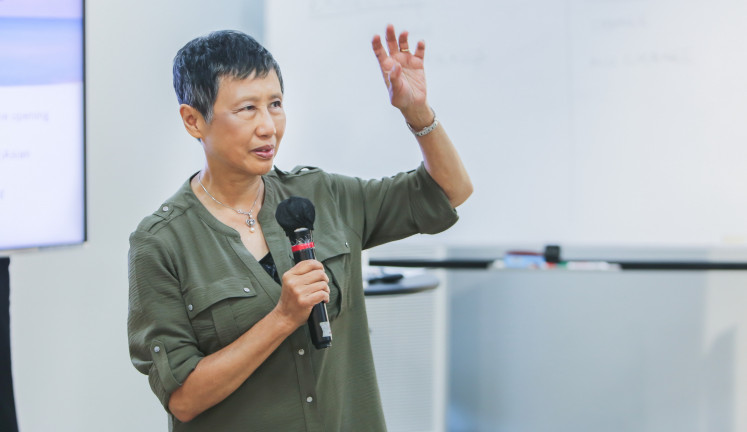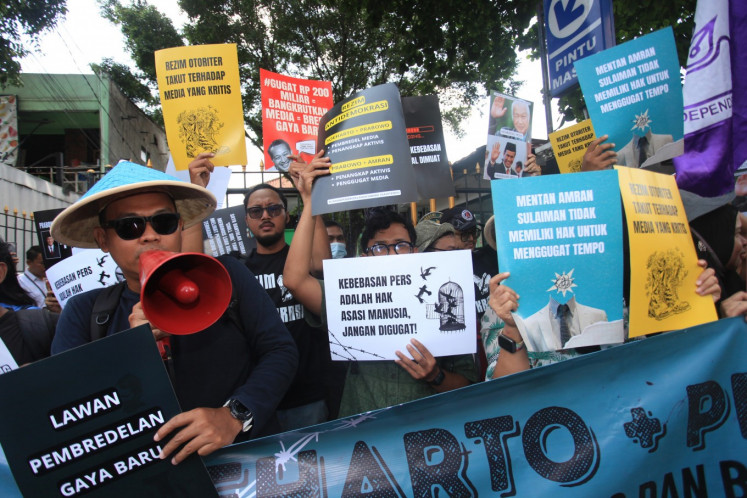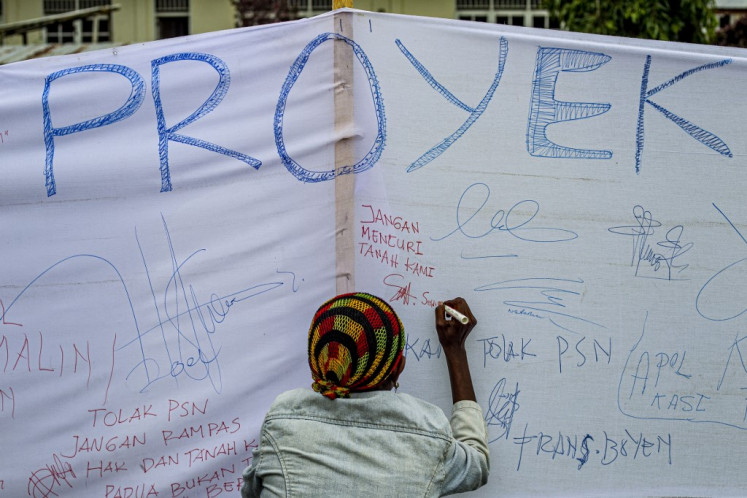Popular Reads
Top Results
Can't find what you're looking for?
View all search resultsPopular Reads
Top Results
Can't find what you're looking for?
View all search resultsPadneçwara dances away differences
Graceful: Pandawa warrior and Arjunaâs son, Abimanyu (Rury Nostalgia, center), convinces wife Utari that she is his only wife although he was once married to Siti Sundari
Change text size
Gift Premium Articles
to Anyone
G
span class="caption" style="width: 437px;">Graceful: Pandawa warrior and Arjuna's son, Abimanyu (Rury Nostalgia, center), convinces wife Utari that she is his only wife although he was once married to Siti Sundari. The scene is shown in Abimanyu Gugur, a Javanese neo-classical dance drama composed by maestro Retno Maruti. All characters in the sequence were represented by female dancers.
In ancient Java, the kingdoms of Yogyakarta and Surakarta were rivals but their descendants have now chosen to set aside their differences to promote cultural heritage.
Padneçwara dance company, founded by married dance maestros Retno Maruti and Sentot Sudiharto, has been carrying out the noble task since 1976 of preserving the rich dance styles of Yogyakarta and Surakarta while at the same time introducing the tradition to international communities.
The co-existence of both worlds was seen in the group's 38th anniversary performance entitled Natyasastra Padneçwara on Friday and Saturday at Gedung Kesenian Jakarta in Pasar Baru, Central Jakarta.
The performance, which consisted of three dances, was opened by a solo dance called Menak Koncar. With graceful and intricate moves originating from Surakarta, dancer Sulistyo Tirtokusumo impressively displayed the anxiety felt by the flamboyant Adipati (duke) Menak Koncar, who had to leave his love Dewi Satiti to fight the powerful Adipati Menakjingga.
The serene ambiance was soon replaced by the strong, dynamic Klana Raja (The Quest of the King) performed by Widaru Krefianto Darmawan, a dance instructor at the Yogyakarta Palace. The dance tells the story of a king who is trying to reach a perfect state of mind and body.
Different colors imbued in a dance performance were also seen in Retno's Javanese neoclassical dance drama Abimanyu Gugur (The Demise of Abimanyu).
Although the dance composition firmly stuck to the rules of Javanese traditional dance, the use of western instruments, such as a trumpet and drums, to create background music for a battle scene gave a strong impression to the whole performance.
'We combined many styles and forms of arts to enrich the cultures,' Retno said after the Friday performance. 'It will also open people's minds to Javanese traditions.'
At war: Kurawa archer Jaiajatra shoots and kills Abimanyu in an epic Bharatayuda battle.
Abimanyu Gugur, which is said to be Retno's masterpiece, is itself an interpretation of Nostalgia, a lyrical prose written by Danarto in 1969. It tells the story of Abimanyu, the teenage son of Arjuna, who is chosen to lead the troops to the epic Bharatayuda battle, during which he meets his death.
Last year, the dance company performed Alap Alapan Sukesi, an interpretation of Sindhunata's novel, Anak Bajang Menggiring Angin (The Dwarf Who Directs the Wind).
In its 38 years of existence, the group has seen interest in 'old' dances fluctuate. However, in the past decade, Padneçwara has maintained a stable number of dancers who gather on Sunday's to practice.
Retno said it the group has 70 active members, ranging from teenagers to grandparents, most of whom are female, including a young Dutch dancer who took on the role of a Kurawa warrior in Abimanyu Gugur.
'I'd rather have a small group of dancers who dance because it feeds their soul than have a lot who dance by merely memorizing the moves,' said the Surakarta-born dancer.
When asked whether the group was influenced by contemporary dance styles, she said that as dancers, they also learned from other genres of dance.
'I'm not against new things. They can provide valuable input and help us improve,' said the 67-year-old, who also has mastered dances from other Indonesian cultures.
Many of the members have day jobs as office workers or company executives, but on Sunday's they turn into professional dancers, practicing not only the skills of the trade but also choreographing and organizing productions.
'We don't need to hire event organizers because we can do everything by ourselves,' Retno said.
For its members, Padneçwara is like a big extended family.
Yuni Trisapto, for instance, has been part of the group for 38 years. Her husband, S. Trisapto, is the stage producer for the group while their only son, Bayu Wicaksana, is the sound engineer of Natyasastra Padneçwara.
A trained Yogyakarta-style dancer, she said that the current members came from different generations of dancers, including Retno's only daughter, Rury Nostalgia.
'There are more young people in the group and with the ongoing re-generation, I believe the group will exist for a long time,' she said.
' Photos by Tertiani ZB Simanjuntak












